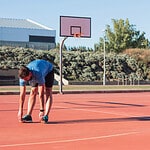Introduction
Knee pain can be a real burden, preventing people from exercising or just enjoying their everyday life. However, there are solutions! This guide introduces rest and recovery strategies for managing knee pain. It looks into how rest and recovery can help relieve symptoms in the long run.
Types of knee issues, simple home exercises to build strength and flexibility, posture tips for physical activities or sports, and knowing when to take time off for complete rest and recovery from exercise – all these topics are covered. The guide even talks about getting the right support from health professionals. This way, you can gain insight into your condition and follow instructions to manage it.
Causes of Knee Pain
Knee pain is common for many. It has a variety of sources. These include:
- overuse
- bursitis
- strains
- sprains
- tendinitis
- arthritis
Furthermore, activities like running, jumping and stairs can worsen the pain. Knowing its causes helps to better manage and treat it.
Overuse
Knee pain can be due to overuse. It can manifest as tendonitis, bursitis or other inflammations. Overusing a joint or muscle causes repetitive strain injury. This is due to repetitive motion that leads to gradual degeneration and damage to the muscles, tendons or ligaments around the knee.
Common causes of overuse include:
- running
- jumping
- lifting weights
- other activities that involve knee flexion and extension
If a person has pain from certain activities, they may need to reduce their intensity or frequency. In severe cases, rest for an extended period is necessary. Physiotherapy, massage, or acupuncture might be helpful. If a person has been exercising for some time without rest days, it is likely their knees are feeling the effects of overtraining and excessive bodily stress from overuse injuries.
Injury
Injury is a common source of knee pain. It varies from minor sprains and contusions to more serious ligament tears, such as ACL or meniscus tears. It is possible for injuries to be misdiagnosed due to other conditions with similar symptoms.
Overuse injuries, such as patellar tendinitis, iliotibial band syndrome and chondromalacia, may also cause knee pain. These injuries often result from sports activities with repetitive joint movements. If the injured part isn’t given proper rest, it can lead to knee pain. But, with rest and recovery, it should be possible to manage and eventually get rid of the knee pain.
Other conditions
Knee pain can be caused by something other than overuse or injury. To get the right treatment, you must identify the source of the pain.
- Inflammatory illnesses like arthritis, gout, lupus, and septic arthritis can bring chronic pain.
- Osteoarthritis is wear-and-tear on the ligaments and tendons around the knee. It is more likely if you are overweight since it adds strain to the joint.
- Tumors or cysts around the kneecap can cause pain during physical activity or rest. This can change joint alignment and affect motion.
- Dislocation or subluxation can happen when playing sports. It can cause swelling and increased bone density. This can lead to more pain for months or years.
- Patellar tendonitis is inflammation or tears in the quadriceps tendon that connects the kneecap and tibia. It often happens after intense exercise or too much volume.
Rest and Recovery
Rest and recovery are two factors that can help manage knee pain. Resting gives the knee a chance to heal. Recovery strengthens the muscles around the knee, which can help reduce the pain. This article looks at how to rest and recover properly. It also looks at the kinds of activities you should not do when you suffer from knee pain:
- Avoid high-impact activities such as running and jumping.
- Avoid activities that involve twisting or turning the knee.
- Avoid activities that put too much strain on the knee, such as heavy lifting.
Ice
Icing is a great way to reduce knee pain. Do it within 48 hours of the injury. Wrap a cold pack in a damp towel and put it on your knee for 10-15 minutes every two hours for a few days. Stop the treatment when your symptoms improve. If there is no improvement after 7-10 days, see a doctor.
Compression
Compression is a recovery technique which can reduce swelling and discomfort. It can be done by applying a medical bandage or elastic sleeve. The fit should be snug, but not tight enough to hinder circulation in the leg.
Compression can be used to manage knee conditions or after exercise. It gives support to the muscles, tendons and ligaments to help heal and prevent injury. The bandage should be monitored for wear or looseness.
Ice packs or ice massages can be used several times daily, if directed by a healthcare provider. This can help with swelling, joint mobility, and pain. Take care not to use extreme heat or cold for extended periods without medical advice.
Elevation
Relieve knee pressure with elevation! Examples include: propping up your knee on pillows while sitting or lying down. Also, reclining or sitting with your knee elevated. This reduces inflammation, swelling, and pain. Plus, if you’re bedridden, make sure your mattress is elevated too.
For extra relief, lay with your foot slightly elevated above your leg for 15 minutes every few hours. Always check with your healthcare provider for any other recovery recommendations.
Stretching
Stretching can help with knee pain, both before and after activities. After activity, target the quadriceps, hamstrings, and hip flexors muscles. This reduces tension around the knee joint.
Dynamic stretching before a workout or physical activity is also beneficial. This makes loosening your joints easier and prevents injury. Squats and lunges target the quads, hamstrings, and hip flexors.
Make stretching a habit! Take a few minutes each day to stretch these areas. When stretching:
- Feel tightness, not pain.
- Hold for 15 seconds or longer if it’s comfortable.
- Do each stretch 3 times on each side, or once per leg if asymmetrical.
- Relax into each movement – don’t pull or tense any area unnecessarily.
Strengthening Exercises
Pain in the knees or its surrounding areas can be caused by many things. Arthritis, a tear of the cartilage, or even an ACL injury are just some of the conditions. It’s important to get proper rest and movement to manage the condition.
Strengthening exercises can help reduce discomfort. Isometric exercises like wall sits tighten the leg muscles without movement. Flexibility exercises should be done with slow movements to reduce strain on sensitive joints or muscles.
Dynamic exercises also help increase strength. Single-leg squats and full squats are great for balance. Do these twice a week, never on consecutive days. If it’s too painful, switch to basic strength building exercises.
In conclusion, rest and recovery strategies, along with strengthening exercises, can reduce knee irritation and enhance overall lower body strength, stability, balance and decrease instances of knee pain. All of this should be done in moderation and with proper form.
Professional Treatment Options
Knee pain can put a damper on your active lifestyle. To get back on track, consider professional treatment options. Rest is important, but more intensive treatments can lead to better results.
In this guide, discover various types of professional treatment to ease your knee pain:
Physical Therapy
Physical therapy is a form of treatment that uses exercise and other physical activities to improve and preserve mobility. It can help with knee pain and disability management, particularly when the problem is related to structure damage or weak muscles.
A physical therapist may recommend certain stretches, exercises and postural corrections. Assistive devices may be used to increase range of motion, strength and coordination. This may help prevent further injury.
Each physical therapy regimen is tailored to meet an individual’s needs and condition. This often involves:
- Strengthening exercises
- Aerobic conditioning
- Balance training
- Manual therapy techniques
- Functional activities
Electrotherapy or aquatic therapy may be used too. The patient may be taught preventative strategies and self-management skills.
It is best to visit a medical doctor first for proper diagnosis and treatment recommendations.
Medication
Medication is a common treatment for knee pain. NSAIDs such as ibuprofen and naproxen can reduce swelling and inflammation. You can take them orally or topically, or get a prescription from your doctor.
Corticosteroid injections are another option. These are inserted into the affected joint and quickly reduce inflammation. Cortisone shots are usually for severe knee pain that other treatments have not helped.
Chronic knee pain can be treated with medications like
- DMARDs
- biologics
- nonopiate analgesics
- opioids
Make sure you follow your doctor’s instructions and be aware of any side effects or drug interactions.
Surgery
Surgery could be prescribed as a knee pain treatment, when the joint has been severely damaged due to age or injury. During the procedure, professionals may do various operations to mend cartilage, ligaments and other tissue in the joint.
Two of the more common surgical knee pain treatments are:
- Arthroscopy. A minimally invasive technique used to fix or take away damaged ligaments and cartilage. It can also be used to treat some forms of arthritis.
- Osteotomy. Where bone from the leg beneath the joint is taken out to reposition and balance the weight. It can be an effective treatment for bunions and osteoarthritis.
In some cases, total knee replacement (arthroplasty) might be advised as an effective solution to long-term knee pain. Here, the broken parts of the joint are removed and replaced with artificial components like plastic or metal inserts. After surgery, physical therapy exercises are normally done to rebuild muscle strength and flexibility around the joint. To get more understanding on how these surgical options can help relieve your symptoms and improve mobility, consult your doctor.
Conclusion
To manage knee pain, it is important to seek professional help. Building strength, improving flexibility, and wearing proper shoes while doing activities, will help. Doing stretches and taking rest periods is key.
Lifestyle changes like losing weight, activity adjustments, and physical therapy can also be helpful in the long-term. Investing time in understanding your body and doing exercises correctly will maximize the potential to recover. Talking to a medical professional like a physiotherapist can help guide to empower yourself through understanding the issue.
Frequently Asked Questions
Q1.What are the best activities for recovering from knee pain?
A1. The best activities for recovering from knee pain depend on the underlying cause, but generally speaking, low-impact exercises such as swimming, cycling, and walking are good for knee pain. Other activities such as strength training, stretching, and yoga can also help to build strength and flexibility in the knee joint.
Q2. How can I relieve knee pain without exercise?
A2. Applying cold or heat packs to the affected area can help to reduce the inflammation and relieve pain. Over-the-counter medications such as ibuprofen or acetaminophen can also be used to reduce pain and inflammation. Additionally, wearing a knee brace can help to provide support and stability to the knee.
Q3. Are there any lifestyle changes I should make to manage my knee pain?
A3. Lifestyle changes can be an important part of managing knee pain. Maintaining a healthy weight, avoiding activities that may aggravate the knee, and quitting smoking can all help to reduce knee pain. Additionally, it’s important to wear supportive shoes with good arch support and cushioning to reduce stress on the knee.





